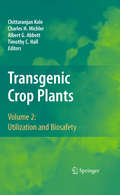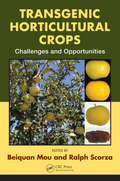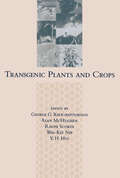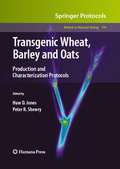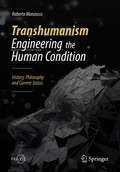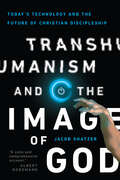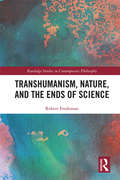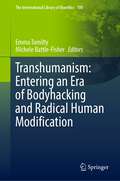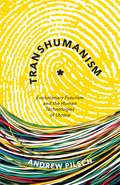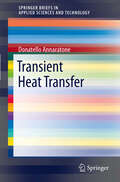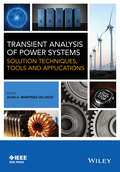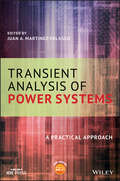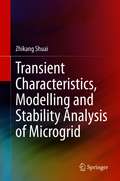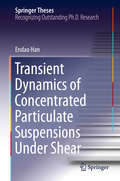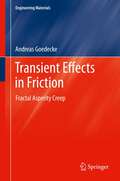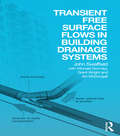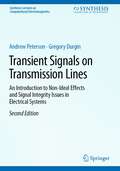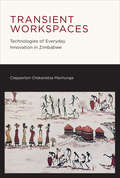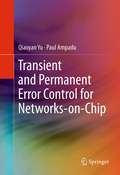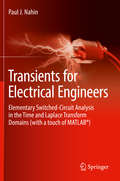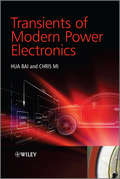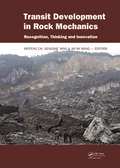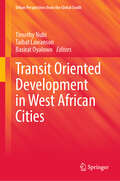- Table View
- List View
Transgenic Crop Plants
by Charles Michler Albert G. Abbott Timothy C. Hall Chittaranjan KoleDevelopment of transgenic crop plants, their utilization for improved agriculture, health, ecology and environment and their socio-political impacts are currently important fields in education, research and industries and also of interest to policy makers, social activists and regulatory and funding agencies. This work prepared with a class-room approach on this multidisciplinary subject will fill an existing gap and meet the requirements of such a broad section of readers. Volume 2 with 13 chapters contributed by 41 eminent scientists from nine countries deliberates on the utilization of transgenic crops for resistance to herbicides, biotic stress and abiotic stress, manipulation of developmental traits, production of biofuel, biopharmaceuticals and algal bioproducts, amelioration of ecology and environment and fostering functional genomics as well as on regulations and steps for commercialization, patent and IPR issues, and compliance to concerns and compulsions of utilizing transgenic plants.
Transgenic Horticultural Crops: Challenges and Opportunities
by Ralph Scorza Beiquan MouAs the world debates the risks and benefits of plant biotechnology, the proportion of the global area of transgenic field crops has increased every year, and the safety and value continues to be demonstrated. Yet, despite the success of transgenic field crops, the commercialization of transgenic horticultural crops (vegetables, fruits, nuts, and or
Transgenic Plants and Crops
by Y. H. Hui Alan McHughen Wai-Kit Nip George G. KhachatouriansWith contributions from nearly 130 internationally renowned experts in the field, this reference details advances in transgenic plant construction and explores the social, political, and legal aspects of genetic plant manipulation. It provides analyzes of the history, genetics, physiology, and cultivation of over 30 species of transgenic seeds, fruits, and vegetables. Stressing the impact of genetic engineering strategies on the nutritional and functional benefit of foods as well as on consumer health and the global market economy, the book covers methods of gene marking, transferring, and tagging public perceptions to the selective breeding, hybridization, and recombinant DNA manipulation of food.
Transgenic Wheat, Barley and Oats
by Huw D. Jones Peter R. ShewryThe understanding of the physical and genetic structure of plant genomes and the determination of phenotypes via interactions of coding and non-coding regions with the environment has quickly become the key to the future of plant breeding and agriculture. In Transgenic Wheat, Barley and Oats: Production and Characterization Protocols, expert investigators contribute the latest protocols for the transformation, regeneration and selection of these three species, using both biolistics and Agrobacterium tumefaciens, in order to fill the need for techniques and resources in this vital area of research. Covering such topics as in vitro Agrobacterium co-cultivation, the manipulation of gene expression, and GM risk assessment, this versatile collection focuses on the study of temperate small grain cereals while many of its readily reproducible procedures could be easily adapted to accommodate other cereals and plants. The in-depth chapters adhere to the highly successful Methods in Molecular BiologyTM series format, featuring brief introductions to the subject, lists of the necessary materials and reagents, step-by-step laboratory protocols and tips on troubleshooting and avoiding known pitfalls. Comprehensive and cutting-edge, Transgenic Wheat, Barley and Oats: Production and Characterization Protocols is an ideal guide for scientists pursuing this powerful, forward-thinking genetic strategy.
Transhumanism - Engineering the Human Condition: History, Philosophy and Current Status (Springer Praxis Books)
by Roberto ManzoccoThis book is designed to offer a comprehensive high-level introduction to transhumanism, an international political and cultural movement that aims to produce a “paradigm shift” in our ethical and political understanding of human evolution. Transhumanist thinkers want the human species to take the course of evolution into its own hands, using advanced technologies currently under development – such as robotics, artificial intelligence, biotechnology, cognitive neurosciences, and nanotechnology – to overcome our present physical and mental limitations, improve our intelligence beyond the current maximum achievable level, acquire skills that are currently the preserve of other species, abolish involuntary aging and death, and ultimately achieve a post-human level of existence. The book covers transhumanism from a historical, philosophical, and scientific viewpoint, tracing its cultural roots, discussing the main philosophical, epistemological, and ethical issues, and reviewing the state of the art in scientific research on the topics of most interest to transhumanists. The writing style is clear and accessible for the general reader, but the book will also appeal to graduate and undergraduate students.
Transhumanism and the Image of God: Today's Technology and the Future of Christian Discipleship
by Jacob ShatzerWe're constantly invited to think about the future of technology as a progressive improvement of tools: our gadgets will continue to evolve, but we humans will stay basically the same. In the future, perhaps even alien species and intelligent robots will coexist alongside humans, who will grapple with challenges and emerge as the heroes. But the truth is that radical technological change has the power to radically shape humans as well. We must be well informed and thoughtful about the steps we're already taking toward a transhuman or even posthuman future. Can we find firm footing on a slippery slope? Biblical ethicist Jacob Shatzer guides us into careful consideration of the future of Christian discipleship in a disruptive technological environment. In Transhumanism and the Image of God, Shatzer explains the development and influence of the transhumanist movement, which promotes a "next stage" in human evolution. Exploring topics such as artificial intelligence, robotics, medical technology, and communications tools, he examines how everyday technological changes have already altered and continue to change the way we think, relate, and understand reality. By unpacking the doctrine of the incarnation and its implications for human identity, he helps us better understand the proper place of technology in the life of the disciple and avoid false promises of a posthumanist vision. We cannot think about technology use today without considering who we will become tomorrow.
Transhumanism, Nature, and the Ends of Science: A Critique of Technoscience (Routledge Studies in Contemporary Philosophy)
by Robert FrodemanThis book offers a social, political, and aesthetic critique of transhumanism and of the accelerating growth of scientific knowledge generally. Rather than improving our lives, science and technology today increasingly leave us debilitated and infantilized. It is time to restrain the runaway ambitions of technoscientific knowledge. The transhumanist goal of human enhancement encapsulates a range of dangerous social pathologies. Like transhumanism itself, these pathologies are rooted in, or in reaction to, the ethos of ‘more’. It’s a cultural love affair with excess, which is prompted by the libertarian standards of our cultural productions. But the attempt to live at the speed of an electron is destined for failure. In response, the author offers a naturalistic account of human flourishing where we attend to the natural rhythms of life. The interdisciplinary orientation of Transhumanism, Nature, and the Ends of Science makes it relevant to scholars and students across a wide range of disciplines, including social and political philosophy, philosophy of technology, science and technology studies, environmental studies, and public policy.
Transhumanism: Entering an Era of Bodyhacking and Radical Human Modification (The International Library of Bioethics #100)
by Michele Battle-Fisher Emma TumiltyThis book surveys the distinctions that underlie the unbound potential and existential risks of life expansion and radical modifications posed by a transhuman world. Humanness is in flux as human bodies are being hacked and altered in their quest for super wellness, super intelligence and super longevity. Now is the time to discuss how best to think about dealing with bodies that have been hacked to exceed natural physical limits or more technically, species typical functioning. Enter the advent of transhumanism to take uncertainty by the horns. According to transhumanists, death is unnecessary and medical conventions undermine the possibility to radically evolve. To biohackers, there is no need to wait to explore the risks that conventional medicine dares not. This book is of interest to anyone interested in tapping into this growing movement of modifying the human body as it is right now.
Transhumanism: Evolutionary Futurism and the Human Technologies of Utopia
by Andrew PilschTranshumanism posits that humanity is on the verge of rapid evolutionary change as a result of emerging technologies and increased global consciousness. However, this insight is dismissed as a naive and controversial reframing of posthumanist thought, having also been vilified as &“the most dangerous idea in the world&” by Francis Fukuyama. In this book, Andrew Pilsch counters these critiques, arguing instead that transhumanism&’s utopian rhetoric actively imagines radical new futures for the species and its habitat.Pilsch situates contemporary transhumanism within the longer history of a rhetorical mode he calls &“evolutionary futurism&” that unifies diverse texts, philosophies, and theories of science and technology that anticipate a radical explosion in humanity&’s cognitive, physical, and cultural potentialities. By conceptualizing transhumanism as a rhetoric, as opposed to an obscure group of fringe figures, he explores the intersection of three major paradigms shaping contemporary Western intellectual life: cybernetics, evolutionary biology, and spiritualism. In analyzing this collision, his work traces the belief in a digital, evolutionary, and collective future through a broad range of texts written by theologians and mystics, biologists and computer scientists, political philosophers and economic thinkers, conceptual artists and Golden Age science fiction writers. Unearthing the long history of evolutionary futurism, Pilsch concludes, allows us to more clearly see the novel contributions that transhumanism offers for escaping our current geopolitical bind by inspiring radical utopian thought.
Transient Heat Transfer
by Donatello AnnaratoneThis book presents a new and direct computational method for transient heat transfer. The approach uses the well-known dimensionless Biot number and a second dimensionless number introduced by the author. The methodology allows for a transient heat transfer calculations without using finite difference programs. The book presents many examples and various tables demonstrating the potential of this new methodology. Many diagrams illustrate the physical phenomena.
Transient Airflow in Building Drainage Systems
by John SwaffieldGiving you the first comprehensive presentation of the ground breaking research undertaken at Heriot Watt University, with Research Council and industrial funding, this book brings a new perspective to the design of building drainage and vent systems. It provides the building services community with clear and verifiable design methods that will be robust enough to meet challenges such as climate change and water conservation; population migration to the mega cities of the developing world, and the consequent pressures of user concentration; the rise of the prestige building and the introduction of new appliances and control strategies. These all combine to make traditional codified design guidance insufficient. Many assumptions in existing codes defining the entrained airflows within building drainage vent systems cannot be theoretically supported, so designers concerned with these systems need analysis and simulation capabilities which are at least as reliable as those enjoyed by other building services practitioners. The Method of Characteristics solution techniques which are well established in the pressure surge field are now used to provide solutions for drainage designers. The material is applied to a whole range of abstract scenarios then to a series of real world applications including the forensic modelling of the SARS virus spread within Amoy Gardens in 2003 and the refurbishment of the O2 Dome. Applications to specialised services, including underground station drainage and highly infectious disease treatment facilities are discussed and demonstrated, alongside the use of design and simulation techniques in support of product development. Aimed at both professional and academic users, this book serves both as a design aid and as a core text for specialist masters courses in public health and building services engineering.
Transient Analysis of Power Systems
by Juan A. Martinez-VelascoThe simulation of electromagnetic transients is a mature field that plays an important role in the design of modern power systems. Since the first steps in this field to date, a significant effort has been dedicated to the development of new techniques and more powerful software tools. Sophisticated models, complex solution techniques and powerful simulation tools have been developed to perform studies that are of supreme importance in the design of modern power systems. The first developments of transients tools were mostly aimed at calculating over-voltages. Presently, these tools are applied to a myriad of studies (e.g. FACTS and Custom Power applications, protective relay performance, simulation of smart grids) for which detailed models and fast solution methods can be of paramount importance.This book provides a basic understanding of the main aspects to be considered when performing electromagnetic transients studies, detailing the main applications of present electromagnetic transients (EMT) tools, and discusses new developments for enhanced simulation capability.Key features: Provides up-to-date information on solution techniques and software capabilities for simulation of electromagnetic transients.Covers key aspects that can expand the capabilities of a transient software tool (e.g. interfacing techniques) or speed up transients simulation (e.g. dynamic model averaging).Applies EMT-type tools to a wide spectrum of studies that range from fast electromagnetic transients to slow electromechanical transients, including power electronic applications, distributed energy resources and protection systems.Illustrates the application of EMT tools to the analysis and simulation of smart grids.
Transient Analysis of Power Systems: A Practical Approach (Wiley - IEEE)
by Juan A. Martinez-VelascoA hands-on introduction to advanced applications of power system transients with practical examples Transient Analysis of Power Systems: A Practical Approach offers an authoritative guide to the traditional capabilities and the new software and hardware approaches that can be used to carry out transient studies and make possible new and more complex research. The book explores a wide range of topics from an introduction to the subject to a review of the many advanced applications, involving the creation of custom-made models and tools and the application of multicore environments for advanced studies. The authors cover the general aspects of the transient analysis such as modelling guidelines, solution techniques and capabilities of a transient tool. The book also explores the usual application of a transient tool including over-voltages, power quality studies and simulation of power electronics devices. In addition, it contains an introduction to the transient analysis using the ATP. All the studies are supported by practical examples and simulation results. This important book: Summarises modelling guidelines and solution techniques used in transient analysis of power systems Provides a collection of practical examples with a detailed introduction and a discussion of results Includes a collection of case studies that illustrate how a simulation tool can be used for building environments that can be applied to both analysis and design of power systems Offers guidelines for building custom-made models and libraries of modules, supported by some practical examples Facilitates application of a transients tool to fields hardly covered with other time-domain simulation tools Includes a companion website with data (input) files of examples presented, case studies and power point presentations used to support cases studies Written for EMTP users, electrical engineers, Transient Analysis of Power Systems is a hands-on and practical guide to advanced applications of power system transients that includes a range of practical examples.
Transient Characteristics, Modelling and Stability Analysis of Microgird
by Zhikang ShuaiThe book focuses on the transient modelling, stability analysis and control of power electronic systems, since these systems face severe safe operation problems the during transient period. It discusses both theoretical analysis and practical applications, highlighting the transient characteristics of converters with different control strategies, and proposes transient modelling and model reduction methods. Furthermore, it classifies the transient stability problems of the system to help the readers gain an understanding of the basic theoretical methods for analysing the power electronic system, at the same time providing sufficient detail to enable engineers to design such systems. Comprehensively describing theoretical analyses, ranging from system modelling and stability analysis to transient control, the book is a valuable resource for researchers, engineers and graduate students in fields of transient modelling, stability analysis and control of power electronic systems.
Transient Control of Gasoline Engines
by Tielong Shen Jiangyan Zhang Xiaohong Jiao Mingxin Kang Junichi Kako Akira OhataCar electronics and digital processing technology have been used to improve the efficiency and performance of engines for decades, yet the main focus is still on static or pseudo-static mode, while the engines loaded in the road vehicles are not always operated at static mode. This book describes the behavior of engine dynamics operated at transient mode as a dynamical system, and uses advanced control theory to design a real-time control strategy that can be used to improve efficiency and emission performance.
Transient Dynamics of Concentrated Particulate Suspensions Under Shear (Springer Theses)
by Endao HanThis thesis demonstrates the first use of high-speed ultrasound imaging to non-invasively probe how the interior of a dense suspension responds to impact. Suspensions of small solid particles in a simple liquid can generate a rich set of dynamic phenomena that are of fundamental scientific interest because they do not conform to the typical behavior expected of either solids or liquids. Most remarkable is the highly counter-intuitive ability of concentrated suspensions to strongly thicken and even solidify when sheared or impacted. The understanding of the mechanism driving this solidification is, however, still limited, especially for the important transient stage while the response develops as a function of time. In this thesis, high-speed ultrasound imaging is introduced to track, for the first time, the transition from the flowing to the solidified state and directly observe the shock-like shear fronts that accompany this transition. A model is developed that agrees quantitatively with the experimental measurements. The combination of imaging techniques, experimental design, and modeling in this thesis represents a major breakthrough for the understanding of the dynamic response of dense suspensions, with important implications for a wide range of applications ranging from the handling of slurries to additive manufacturing.
Transient Effects in Friction
by Andreas GoedeckeTransient friction effects determine the behavior of a wide class of mechatronic systems. Classic examples are squealing brakes, stiction in robotic arms, or stick-slip in linear drives. To properly design and understand mechatronic systems of this type, good quantitative models of transient friction effects are of primary interest. The theory developed in this book approaches this problem bottom-up, by deriving the behavior of macroscopic friction surfaces from the microscopic surface physics. The model is based on two assumptions: First, rough surfaces are inherently fractal, exhibiting roughness on a wide range of scales. Second, transient friction effects are caused by creep enlargement of the real area of contact between two bodies. This work demonstrates the results of extensive Finite Element analyses of the creep behavior of surface asperities, and proposes a generalized multi-scale area iteration for calculating the time-dependent real contact between two bodies. The toolset is then demonstrated both for the reproduction of a variety of experimental results on transient friction as well as for system simulations of two example systems.
Transient Free Surface Flows in Building Drainage Systems
by John SwaffieldClimate change will present a series of challenges to engineers concerned with the provision of both building internal appliance drainage networks and rainwater systems within the building boundary, generally identified as the connection to the sewer network. Climate change is now recognised as presenting both water shortage and enhanced rainfall design scenarios.In response to predictions about immanent climate change Transient Free Surface Flows in Building Drainage Systems addresses problems such as the reduction in water available to remove waste from buildings, and conversely, the increase in frequency of tropical-type torrential rain. Starting with introductory chapters that explain the theories and principles of solid transport, free surface flows within drainage networks, and attenuating appliance discharge flows, this book allows readers from a variety of backgrounds to fully engage with this crucial subject matter. Later chapters apply these theories to the design of sanitary and rainwater systems. Case studies highlight the applicability of the method in assessing the appropriateness of design approaches.In this unique book, research in modelling for free surface flows at Edinburgh’s Heriot-Watt University is drawn on to provide a highly authoritative, physics-based study of this complex engineering issue.
Transient Signals on Transmission Lines: An Introduction to Non-Ideal Effects and Signal Integrity Issues in Electrical Systems (Synthesis Lectures on Computational Electromagnetics)
by Andrew Peterson Gregory DurginThis book provides an introduction to transmission line effects in the time domain. Fundamentals including time of flight, impedance discontinuities, proper termination schemes, nonlinear and reactive loads, and crosstalk are considered. Required prerequisite knowledge is limited to conventional circuit theory. The material is tutorial for electrical and computer engineers on the topic of transient signals on transmission lines. Emphasis has been placed on aspects of the subject that have application to signal integrity and high-speed digital circuit design issues, including proper termination schemes to avoid impedance discontinuities, reactive and nonlinear loads, and an introduction to crosstalk.The coverage focuses on the very important topic of transmission line transients which have been de-emphasized in most current textbooks. This book is prepared to supplement traditional texts for advanced students studying electromagnetics and for a vast array of practicing electrical engineers, computer engineers and material scientists with interests in signal integrity and high-speed digital design.In this second edition, examples and new problems have been added throughout. A new chapter on differential transmission lines has also been incorporated
Transient Workspaces: Technologies of Everyday Innovation in Zimbabwe (The\mit Press Ser.)
by Clapperton Chakanets MavhungaAn account of technology in Africa from an African perspective, examining hunting in Zimbabwe as an example of an innovative mobile workspace.In this book, Clapperton Mavhunga views technology in Africa from an African perspective. Technology in his account is not something always brought in from outside, but is also something that ordinary people understand, make, and practice through their everyday innovations or creativities—including things that few would even consider technological. Technology does not always originate in the laboratory in a Western-style building but also in the society in the forest, in the crop field, and in other places where knowledge is made and turned into practical outcomes.African creativities are found in African mobilities. Mavhunga shows the movement of people as not merely conveyances across space but transient workspaces. Taking indigenous hunting in Zimbabwe as one example, he explores African philosophies of mobilities as spiritually guided and of the forest as a sacred space. Viewing the hunt as guided mobility, Mavhunga considers interesting questions of what constitutes technology under regimes of spirituality. He describes how African hunters extended their knowledge traditions to domesticate the gun, how European colonizers, with no remedy of their own, turned to indigenous hunters for help in combating the deadly tsetse fly, and examines how wildlife conservation regimes have criminalized African hunting rather than enlisting hunters (and their knowledge) as allies in wildlife sustainability. The hunt, Mavhunga writes, is one of many criminalized knowledges and practices to which African people turn in times of economic or political crisis. He argues that these practices need to be decriminalized and examined as technologies of everyday innovation with a view toward constructive engagement, innovating with Africans rather than for them.
Transient and Permanent Error Control for Networks-on-Chip
by Paul Ampadu Qiaoyan YuThis book addresses reliability and energy efficiency of on-chip networks using cooperative error control. It describes an efficient way to construct an adaptive error control codec capable of tracking noise conditions and adjusting the error correction strength at runtime. Methods are also presented to tackle joint transient and permanent error correction, exploiting the redundant resources already available on-chip. A parallel and flexible network simulator is also introduced, which facilitates examining the impact of various error control methods on network-on-chip performance.
Transients for Electrical Engineers: Elementary Switched-Circuit Analysis in the Time and Laplace Transform Domains (with a touch of MATLAB®)
by Paul J. NahinThis book offers a concise introduction to the analysis of electrical transients aimed at students who have completed introductory circuits and freshman calculus courses. While it is written under the assumption that these students are encountering transient electrical circuits for the first time, the mathematical and physical theory is not ‘watered-down.’ That is, the analysis of both lumped and continuous (transmission line) parameter circuits is performed with the use of differential equations (both ordinary and partial) in the time domain, and the Laplace transform. The transform is fully developed in the book for readers who are not assumed to have seen it before. The use of singular time functions (unit step and impulse) is addressed and illustrated through detailed examples.The appearance of paradoxical circuit situations, often ignored in many textbooks (because they are, perhaps, considered ‘difficult’ to explain) is fully embraced as an opportunity to challenge students. In addition, historical commentary is included throughout the book, to combat the misconception that the material in engineering textbooks was found engraved on Biblical stones, rather than painstakingly discovered by people of genius who often went down many wrong paths before finding the right one. MATLAB® is used throughout the book, with simple codes to quickly and easily generate transient response curves.
Transients of Modern Power Electronics
by Chris Mi Hua BaiIn high power, high voltage electronics systems, a strategy to manage short timescale energy imbalances is fundamental to the system reliability. Without a theoretical framework, harmful local convergence of energy can affect the dynamic process of transformation, transmission, and storage which create an unreliable system.With an original approach that encourages understanding of both macroscopic and microscopic factors, the authors offer a solution. They demonstrate the essential theory and methodology for the design, modeling and prototyping of modern power electronics converters to create highly effective systems. Current applications such as renewable energy systems and hybrid electric vehicles are discussed in detail by the authors.Key features:offers a logical guide that is widely applicable to power electronics across power supplies, renewable energy systems, and many other areasanalyses the short-scale (nano-micro second) transient phenomena and the transient processes in nearly all major timescales, from device switching processes at the nanoscale level, to thermal and mechanical processes at second levelexplores transient causes and shows how to correct them by changing the control algorithm or peripheral circuitincludes two case studies on power electronics in hybrid electric vehicles and renewable energy systemsPractitioners in major power electronic companies will benefit from this reference, especially design engineers aiming for optimal system performance. It will also be of value to faculty staff and graduate students specializing in power electronics within academia.
Transit Development in Rock Mechanics: Recognition, Thinking and Innovation
by Meifeng Cai Jin’an Wang Gengshe YangTransit Development in Rock Mechanics Recognition, Thinking and Innovation contains 150 papers presented at the 3rd ISRM International Young Scholars Symposium on Rock Mechanics (8-10 November 2014, Xi an, China). The volume focusses on the transitional development in rock mechanics research from surface to underground mining and from shallow to a
Transit Oriented Development in West African Cities (GeoJournal Library)
by Taibat Lawanson Basirat Oyalowo Timothy NubiThe book addresses conceptual issues around urban transportation policy and practice in selected west African cities. It highlights the institutional, socio economic and infrastructural barriers of transit-oriented development in West Africa. Through a series of case studies, the chapters present how transport governance systems affect housing, land, infrastructure development, urbanization dynamics, construction and the urban poor.The chapters in this book are written by authors from multi-disciplinary backgrounds including architecture, construction management, real estate, urban planning and public health, and are members of the African Research Network on Urbanization and Habitable Cities, a research network supported by the UKRI African Research Universities Alliance Capacity Building Programme. By providing a solid empirical portrait based on lived and research experience, this book will be a great resource to students, academics and policy makers in transport, urbanplanning and development policy as well as social scientists.
